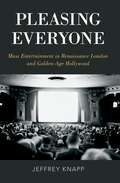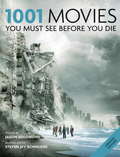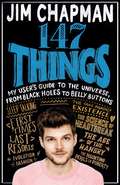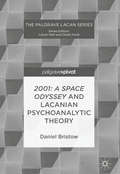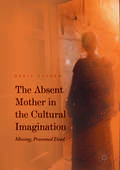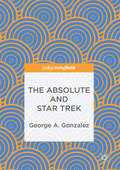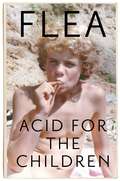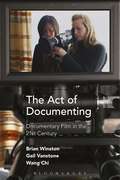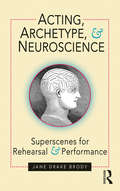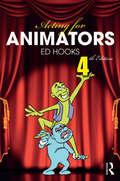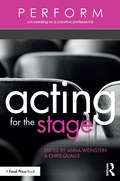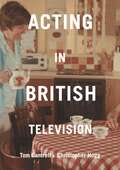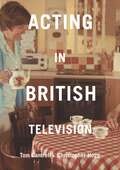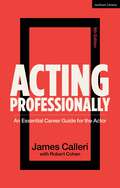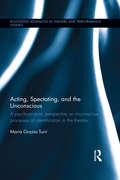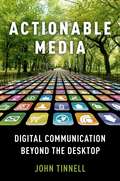- Table View
- List View
British Children's Cinema: From the Thief of Bagdad to Wallace and Gromit
by Noel BrownBritish children's films have played a part in the childhoods of generations of young people around the world for over a century. Until now, however, their cherished status has remained largely unexplored. In this book, Noel Brown relates the history of children's cinema in Britain from the early years of commercial cinema to the present day, to reveal the reasons behind its acclaim in international popular culture.Drawing on multiple sources, Brown provides in-depth analysis of a range of iconic films, including The Railway Children, The Thief of Bagdad, Bugsy Malone, the Harry Potter films,Mary Poppins, Nanny McPhee, Paddington, Oliver!, and Aardman's Wallace and Gromit series. Futhermore, he investigates industrial and commercial contexts, such as the role of the Children's Film Foundation; and includes revealing insights on changing social and cultural norms, such as the once-sacred tradition of Saturday morning cinema. Brown challenges common prejudices that children's films are inherently shallow or simplistic, revealing the often complex strategies that underpin their enduring appeal to audiences of all ages and backgrounds.In addition, he shows how the films allow a privileged access to historic cultures and the nation's political past.In doing so, Brown firmly establishes children's cinema as an important genre not only for students and scholars of film studies but also for those interested in socio-cultural history, the production and reception of popular entertainment and anyone looking for entertainment, escapism and nostalgia.
Pleasing Everyone: Mass Entertainment in Renaissance London and Golden-Age Hollywood
by Jeffrey KnappShakespeare's plays were immensely popular in their own day -- so why do we refuse to think of them as mass entertainment? In Pleasing Everyone, author Jeffrey Knapp opens our eyes to the uncanny resemblance between Renaissance drama and the incontrovertibly mass medium of Golden-Age Hollywood cinema. Through fascinating explorations of such famous plays as Hamlet, The Roaring Girl, and The Alchemist, and such celebrated films as Citizen Kane, The Jazz Singer, and City Lights, Knapp challenges some of our most basic assumptions about the relationship between art and mass audiences. Above all, Knapp encourages us to resist the prejudice that mass entertainment necessarily simplifies and cheapens whatever it touches. As Knapp shows, it was instead the ceaseless pressure to please everyone that helped generate the astonishing richness and complexity of Renaissance drama as well as of Hollywood film.
1001 Movies You Must See Before You Die: You Must See Before You Die 2011 (1001)
by Steven Jay Schneider"I have, by the way, seen 943 of the 1001 movies, and am carefully rationing the remaining titles to prolong my life." - Roger Ebert"1001 ways to give cinema new scope." - The HeraldExpert critics in each genre of film, from romance to horror and sci-fi, have once again painstakingly revised this list of essential must see-movies, cut and added films to bring the must-watch list bang up to date for 2013, from great classics like The Birth of a Nation and Gone With the Wind to recent Oscar winners like Life of Pi, Amour, Argo and the blockbusters that is Skyfall. Each entry tells you exactly why these films deserve inclusion in this definitive illustrated list, engaging readers in each film's concept development and production, including curious trivia facts about the movies, as well as the most famous pieces of memorabilia associated with them.Illustrated with hundreds of stunning film stills, portraits and poster art 1001 Movies You Must See Before You Dieoffers an incredible visual insight into the world of modern cinema. It puts together the most significant movies from all genres, from animation to Western, through action, comedy, documentary, musical, noir, romance, thriller, short and sci-fi. Movies from over 30 different countries have been included, offering a truly wide multi-cultural perspective, and the time span includes more than a century of extraordinary cinematography. Packed with vital statistics, and a few facts that might surprise you, this is a collector's must for the bookshelf as well as an entertaining read for all those who love the world of film. Whether your passion lies with The Blue Angel or Blue Velvet, from the films you shouldn't have missed the first time around, to the films you can see again and again, 1001 Movies You Must See Before You Die is the definitive guide for all movie lovers.Contents includes... Introduction19001910192019301940 195019601970 198019902000
147 Things: A hilariously brilliant guide to this thing called life
by Jim Chapman'It's Sapiens for teenagers.' The TimesLIFE IS WEIRD.Nothing gives you a sense of perspective like finding out just how weird.I'm an extremely curious chap and with this book I wanted to share the content of my noggin, because I think these are the 147 things that have helped me through this thing we call life. Sometimes because it shows how lucky we are to be here at all, but often because I’m a moron and learned whatever lesson it taught me the hard way, and I’d like to save you the pain of making the same mistakes (I refer here to the waxing of my pubic hair).Ever wondered if first times are over-rated (hint: they are), whether you’ll ever find the one (hint: there are 7 billion of us) or pondered the sheer unlikelihood of the you who is you being in the world right now? If so, then YouTube superstar and fact-obsessed, over-sharer Jim Chapman is here to explain it all – whether it’s why your heart actually aches after a break-up, what’s happening when you get hangry, or why people are just so plain RUDE online.Along the way, we’ll find out how much fun he has when Tanya’s sleep-talking and why he looked like a gangly T-rex with wonky teeth when he was a teenager. As with his videos, no subject is off-limits, as Jim lifts the lid on his life and his relationships, sharing embarrassing stories and things he’s learnt along the way (trust us, the thing about kangaroos will really freak you out).
2001: A Space Odyssey and Lacanian Psychoanalytic Theory
by Daniel BristowIn 1968, Stanley Kubrick completed and released his magnum opus motion picture 2001: A Space Odyssey; a time that was also tremendously important in the formation of the psychoanalytic theory of Jacques Lacan. Bringing these figures together, Bristow offers a study that goes beyond, as the film did. He extends Lacan’s late topological insights, delves into conceptualisations of desire, in G. W. F. Hegel, Alexandre Kojève, and Lacan himself, and deals with the major themes of cuts (filmic and psychoanalytic); space; silence; surreality; and ‘das Ding’, in relation to the movie’s enigmatic monolith. This book is a tour de force of psychoanalytic theory and space odyssey that will appeal to academics and practitioners of psychoanalysis and film studies, as well as to any fan of Kubrick’s work.
2001: A Space Odyssey and Lacanian Psychoanalytic Theory
by Daniel BristowIn 1968, Stanley Kubrick completed and released his magnum opus motion picture 2001: A Space Odyssey; a time that was also tremendously important in the formation of the psychoanalytic theory of Jacques Lacan. Bringing these figures together, Bristow offers a study that goes beyond, as the film did. He extends Lacan’s late topological insights, delves into conceptualisations of desire, in G. W. F. Hegel, Alexandre Kojève, and Lacan himself, and deals with the major themes of cuts (filmic and psychoanalytic); space; silence; surreality; and ‘das Ding’, in relation to the movie’s enigmatic monolith. This book is a tour de force of psychoanalytic theory and space odyssey that will appeal to academics and practitioners of psychoanalysis and film studies, as well as to any fan of Kubrick’s work.
The Absent Mother in the Cultural Imagination: Missing, Presumed Dead
by Berit ÅströmThis anthology explores the recurring trope of the dead or absent mother in Western cultural productions. Across historical periods and genres, this dialogue has been employed to articulate and debate questions of politics and religion, social and cultural change as well as issues of power and authority within the family. Åström seeks to investigate the many functions and meanings of the dialogue by covering extensive material from the 1200s to 2014 including hagiography, romances, folktales, plays, novels, children’s literature and graphic novels, as well as film and television. This is achieved by looking at the discourse both as products of the time and culture that produced the various narratives, and as part of an on-going cultural conversation that spans the centuries, resulting in an innovative text that will be of great interest to all scholars of gender, feminist and media studies.
The Absent Mother in the Cultural Imagination: Missing, Presumed Dead
by Berit ÅströmThis anthology explores the recurring trope of the dead or absent mother in Western cultural productions. Across historical periods and genres, this dialogue has been employed to articulate and debate questions of politics and religion, social and cultural change as well as issues of power and authority within the family. Åström seeks to investigate the many functions and meanings of the dialogue by covering extensive material from the 1200s to 2014 including hagiography, romances, folktales, plays, novels, children’s literature and graphic novels, as well as film and television. This is achieved by looking at the discourse both as products of the time and culture that produced the various narratives, and as part of an on-going cultural conversation that spans the centuries, resulting in an innovative text that will be of great interest to all scholars of gender, feminist and media studies.
The Absolute and Star Trek
by George A. GonzalezThis volume explains how Star Trek allows viewers to comprehend significant aspects of Georg Hegel’s concept the absolute, the driving force behind history.Gonzalez, with wit and wisdom, explains how Star Trek exhibits central elements of the absolute. He describes how themes and ethos central to the show display the concept beautifully. For instance, the show posits that people must possess the correct attitudes in order to bring about an ideal society: a commitment to social justice; an unyielding commitment to the truth; and a similar commitment to scientific, intellectual discovery. These characteristics serve as perfect embodiments of Hegel’s conceptualization, and Gonzalez's analysis is sharp and exacting.
The Absolute and Star Trek
by George A. GonzalezThis volume explains how Star Trek allows viewers to comprehend significant aspects of Georg Hegel’s concept the absolute, the driving force behind history.Gonzalez, with wit and wisdom, explains how Star Trek exhibits central elements of the absolute. He describes how themes and ethos central to the show display the concept beautifully. For instance, the show posits that people must possess the correct attitudes in order to bring about an ideal society: a commitment to social justice; an unyielding commitment to the truth; and a similar commitment to scientific, intellectual discovery. These characteristics serve as perfect embodiments of Hegel’s conceptualization, and Gonzalez's analysis is sharp and exacting.
Acid For The Children - The autobiography of Flea, the Red Hot Chili Peppers legend: A Memoir
by FleaFlea, the iconic bassist and co-founder, alongside Anthony Kiedis, of the immortal Red Hot Chili Peppers finally tells his fascinating origin story, complete with all the dizzying highs and the gutter lows you'd expect from an LA street rat turned world-famous rock star.Michael Peter Balzary was born in Melbourne, Australia, on October 16, 1962. His more famous stage name, Flea, and his wild ride as the renowned bass player for the Red Hot Chili Peppers was in a far and distant future. Little Michael from Oz moved with his very conservative, very normal family to Westchester, New York, where life as he knew it was soon turned upside down. His parents split up and he and his sister moved into the home of his mother's free-wheeling, jazz musician boyfriend - trading in rules, stability, and barbecues for bohemian values, wildness, and Sunday afternoon jazz parties where booze, weed, and music flowed in equal measure. There began Michael's life-long journey to channel all the frustration, loneliness, love, and joy he felt into incredible rhythm.When Michael's family moved to Los Angeles in 1972, his home situation was rockier than ever. He sought out a sense of belonging elsewhere, spending most of his days partying, playing basketball, and committing petty crimes. At Fairfax High School, he met another social outcast, Anthony Kiedis, who quickly became his soul brother, the yin to his yang, his partner in mischief. Michael joined some bands, fell in love with performing, and honed his skills. But it wasn't until the night when Anthony, excited after catching a Grandmaster Flash concert, suggested they start their own band that he is handed the magic key to the cosmic kingdom.Acid for the Children is as raw, entertaining and wildly unpredictable as its author. It's both a tenderly evocative coming of age story and a raucous love letter to the power of music and creativity.
The Act of Documenting: Documentary Film in the 21st Century
by Brian Winston Gail Vanstone Wang ChiDocumentary has never attracted such audiences, never been produced with such ease from so many corners of the globe, never embraced such variety of expression. The very distinctions between the filmed, the filmer and the spectator are being dissolved. The Act of Documenting addresses what this means for documentary's 21st century position as a genus in the “class” cinema; for its foundations as, primarily, a scientistic, eurocentric and patriarchal discourse; for its future in a world where assumptions of photographic image integrity cannot be sustained. Unpacked are distinctions between performance and performativy and between different levels of interaction, linearity and hypertextuality, engagement and impact, ethics and conditions of reception. Winston, Vanstone and Wang Chi explore and celebrate documentary's potentials in the digital age.
The Act of Documenting: Documentary Film in the 21st Century
by Brian Winston Gail Vanstone Wang ChiDocumentary has never attracted such audiences, never been produced with such ease from so many corners of the globe, never embraced such variety of expression. The very distinctions between the filmed, the filmer and the spectator are being dissolved. The Act of Documenting addresses what this means for documentary's 21st century position as a genus in the “class” cinema; for its foundations as, primarily, a scientistic, eurocentric and patriarchal discourse; for its future in a world where assumptions of photographic image integrity cannot be sustained. Unpacked are distinctions between performance and performativy and between different levels of interaction, linearity and hypertextuality, engagement and impact, ethics and conditions of reception. Winston, Vanstone and Wang Chi explore and celebrate documentary's potentials in the digital age.
Acting, Archetype, and Neuroscience: Superscenes for Rehearsal and Performance
by Jane Drake Brody"How do we move actors into the less accessible regions of themselves and release hotter, more dangerous, and less literal means of approaching a role?" Superscenes are a revolutionary new mode of teaching and rehearsal, allowing the actor to discover and utilize the primal energies underlying dramatic texts. In Acting, Archetype, and Neuroscience Jane Drake Brody draws upon a lifetime’s experience in the theatre, alongside the best insights into pedagogical practice in the field, the work of philosophers and writers who have focused on myth and archetype, and the latest insights of neuroscience. The resulting interdisciplinary, exciting volume works to: Mine the essentials of accepted acting theory while finding ways to access more primally-based human behavior in actors Restore a focus on storytelling that has been lost in the rush to create complex characters with arresting physical and vocal lives Uncover the mythical bones buried within every piece of dramatic writing; the skeletal framework upon which hangs the language and drama of the play itself Focus on the actor’s body as the only place where the conflict inherent in drama can be animated. Acting, Archetype, and Neuroscience weaves together a wealth of seemingly disparate performance methods, exciting actors to imaginatively and playfully take risks they might otherwise avoid. A radical new mixture of theory and practice by a highly respected teacher of acting, this volume is a must-read for students and performance practitioners alike.
Acting, Archetype, and Neuroscience: Superscenes for Rehearsal and Performance
by Jane Drake Brody"How do we move actors into the less accessible regions of themselves and release hotter, more dangerous, and less literal means of approaching a role?" Superscenes are a revolutionary new mode of teaching and rehearsal, allowing the actor to discover and utilize the primal energies underlying dramatic texts. In Acting, Archetype, and Neuroscience Jane Drake Brody draws upon a lifetime’s experience in the theatre, alongside the best insights into pedagogical practice in the field, the work of philosophers and writers who have focused on myth and archetype, and the latest insights of neuroscience. The resulting interdisciplinary, exciting volume works to: Mine the essentials of accepted acting theory while finding ways to access more primally-based human behavior in actors Restore a focus on storytelling that has been lost in the rush to create complex characters with arresting physical and vocal lives Uncover the mythical bones buried within every piece of dramatic writing; the skeletal framework upon which hangs the language and drama of the play itself Focus on the actor’s body as the only place where the conflict inherent in drama can be animated. Acting, Archetype, and Neuroscience weaves together a wealth of seemingly disparate performance methods, exciting actors to imaginatively and playfully take risks they might otherwise avoid. A radical new mixture of theory and practice by a highly respected teacher of acting, this volume is a must-read for students and performance practitioners alike.
Acting for Animators: 4th Edition
by Ed HooksEd Hooks' essential acting guidebook for animators has been fully revised and updated in this 4th edition. Hooks uses classical acting theory – from Aristotle to Stanislavsky and beyond – to explain everything from character analysis and physical movement to facial expression and scene structure. He speaks directly to animators, instead of stage or screen actors. Acting for Animators is an invaluable primer for beginner animators and a useful reference for experienced pros. New to this fourth edition: - 6 new scene-by-scene acting analyses of animated feature films, including Zootopia and The Little Prince - an annotated analysis of Walt Disney’s famous 1935 memo to Don Graham, regarding how best to train animators - advice to the animator about how best to perform visual references - a chapter on Virtual Reality - an online database of Ed’s previous film analyses, all in one place.
Acting for Animators (PDF): 4th Edition
by Ed HooksEd Hooks' essential acting guidebook for animators has been fully revised and updated in this 4th edition. Hooks uses classical acting theory – from Aristotle to Stanislavsky and beyond – to explain everything from character analysis and physical movement to facial expression and scene structure. He speaks directly to animators, instead of stage or screen actors. Acting for Animators is an invaluable primer for beginner animators and a useful reference for experienced pros. New to this fourth edition: - 6 new scene-by-scene acting analyses of animated feature films, including Zootopia and The Little Prince - an annotated analysis of Walt Disney’s famous 1935 memo to Don Graham, regarding how best to train animators - advice to the animator about how best to perform visual references - a chapter on Virtual Reality - an online database of Ed’s previous film analyses, all in one place.
Acting for the Stage (PERFORM)
by Anna Weinstein Chris QuallsActing for the Stage is a highly accessible guide to the business of theater acting, written for those interested in pursuing acting as a profession. This book is a collection of essays by and interviews with talented artists and businesspeople who have built successful careers in the theater; it’s a goldmine of career advice that might take years to find on your own. Herein, the myths around professional acting are dispelled, and the mysteries revealed. Acting for the Stage illuminates practical strategies to help you build a life as a theater professional and find financial rewards and creative fulfillment in the process. Contains essays by and interviews with working stage actors, acting coaches, directors, writers, and agents. Features discussions on selecting a graduate school program, choosing acting classes and workshops, making the most out of your showcase, landing an agent, networking and promoting yourself, and the business of casting. Covers issues of money management, balancing the highs and lows of the profession, finding work to nourish your acting career, and building your creative team and support network.
Acting for the Stage (PERFORM)
by Anna Weinstein Chris QuallsActing for the Stage is a highly accessible guide to the business of theater acting, written for those interested in pursuing acting as a profession. This book is a collection of essays by and interviews with talented artists and businesspeople who have built successful careers in the theater; it’s a goldmine of career advice that might take years to find on your own. Herein, the myths around professional acting are dispelled, and the mysteries revealed. Acting for the Stage illuminates practical strategies to help you build a life as a theater professional and find financial rewards and creative fulfillment in the process. Contains essays by and interviews with working stage actors, acting coaches, directors, writers, and agents. Features discussions on selecting a graduate school program, choosing acting classes and workshops, making the most out of your showcase, landing an agent, networking and promoting yourself, and the business of casting. Covers issues of money management, balancing the highs and lows of the profession, finding work to nourish your acting career, and building your creative team and support network.
Acting in British Television
by Tom Cantrell Christopher HoggActing in British Television is the first in-depth exploration of acting processes in British television. Focused around sixteen new interviews with celebrated British actors, including Rebecca Front, Julie Hesmondhalgh, Ken Stott, Penelope Wilton and John Hannah, this fascinating text delves behind the scenes of a range of British television programmes in order to find out how actors build their characters for television, how they work on set and location, and how they create their critically-acclaimed portrayals. The book looks at actors’ work across four diverse but popular genres: - soap opera - police and medical drama - comedy - period drama Its insightful discussion of hit programmes such as Downton Abbey, Rebus, The Thick of It, Coronation Street and Poldark, and its critical and contextual post-interview analysis, makes the text an essential read for students, academics and anyone interested in acting and British television.
Acting in British Television
by Tom Cantrell Christopher HoggThis fascinating text offers the first in-depth exploration of acting processes in British television. Focused around 16 new interviews with celebrated British actors, including Rebecca Front, Julie Hesmondhalgh, Ken Stott, Penelope Wilton and John Hannah, this rich resource delves behind the scenes of a range of British television programmes in order to find out how actors build their characters for television, how they work on set and location, and how they create their critically acclaimed portrayals. The book looks at actors' work across four diverse but popular genres: soap opera; police and medical drama; comedy; and period drama. Its insightful discussion of hit programmes and its critical and contextual post-interview analysis, makes the text an essential read for students across television and film studies, theatre, performance and acting, and cultural and media studies, as well as academics and anyone interested in acting and British television.
Acting Professionally: An Essential Career Guide for the Actor
by Professor Robert Cohen James CalleriFilled with essential advice and highlighting pitfalls to avoid, Acting Professionally gives a clear understanding of how acting careers are built and sustained. Now in its 9th edition, this book has become the leading book in the field since the first edition published in 1972.Critically, this new edition reflects the vital changes in the industry as a result of the Black Lives Matter, Time's Up and MeToo movements, and the Covid-19 pandemic. This new edition acknowledges and seeks to address the challenges of the industry often faced by actors when it comes to race, ethnicity, gender, diversity, and sexuality. It includes an extensive new section on the industry to reflect the 21st century, including signposting new resources and insights for the young actor, and considers the shifting landscape and opportunities offered by TV streaming, films, voiceover, internet, audiobooks, and podcasts. This 9th edition speaks to the changed landscape of unions, representation, self-tape auditioning and other best and up to date practices in the industry, ensuring that it's a book that's useful, relevant and accessible to every actor starting out today.
Acting, Spectating and the Unconscious: A psychoanalytic perspective on unconscious mechanisms of identification in spectating and acting in the theatre. (Routledge Advances in Theatre & Performance Studies)
by Maria Grazia TurriFrom Aristotle’s theory of tragic katharsis onwards, theorists of the theatre have long engaged with the question of what spectatorship entails. This question has, directly or indirectly, often been extended to the investigation of acting. Acting, Spectating, and the Unconscious approaches the unconscious aspects of spectatorship and acting afresh. Interweaving psychoanalytic descriptions of processes such as transference, unconscious phantasy, and alpha-function with an in-depth survey of theories of spectating and acting from thinkers such as Brecht, Diderot, Rousseau and Plato, Maria Grazia Turri offers a significant insight into the emotions inherent in both the art of the actor, and the spectator’s experience. A compelling investigation of the unconscious communication between spectators and actors, this volume is a must-read for students and scholars fascinated by theatre spectatorship.
Acting, Spectating and the Unconscious: A psychoanalytic perspective on unconscious mechanisms of identification in spectating and acting in the theatre. (Routledge Advances in Theatre & Performance Studies)
by Maria Grazia TurriFrom Aristotle’s theory of tragic katharsis onwards, theorists of the theatre have long engaged with the question of what spectatorship entails. This question has, directly or indirectly, often been extended to the investigation of acting. Acting, Spectating, and the Unconscious approaches the unconscious aspects of spectatorship and acting afresh. Interweaving psychoanalytic descriptions of processes such as transference, unconscious phantasy, and alpha-function with an in-depth survey of theories of spectating and acting from thinkers such as Brecht, Diderot, Rousseau and Plato, Maria Grazia Turri offers a significant insight into the emotions inherent in both the art of the actor, and the spectator’s experience. A compelling investigation of the unconscious communication between spectators and actors, this volume is a must-read for students and scholars fascinated by theatre spectatorship.
ACTIONABLE MEDIA C: Digital Communication Beyond the Desktop
by John TinnellIn 1991, Mark Weiser and his team at Xerox PARC declared they were reinventing computers for the twenty-first century. The computer would become integrated into the fabric of everyday life; it would shift to the background rather than being itself an object of focus. The resulting rise of ubiquitous computing (smartphones, smartglasses, smart cities) have since thoroughly colonized our digital landscape. In Actionable Media, John Tinnell contends that there is an unsung rhetorical dimension to Weiser's legacy, which stretches far beyond recent iProducts. Taking up Weiser's motto, "Start from the arts and humanities," Tinnell develops a theoretical framework for understanding nascent initiatives--the Internet of things, wearable interfaces, augmented reality--in terms of their intellectual history, their relationship to earlier communication technologies, and their potential to become vibrant platforms for public culture and critical media production. It is clear that an ever-widening array of everyday spaces now double as venues for multimedia authorship. Writers, activists, and students, in cities and towns everywhere, are digitally augmenting physical environments. Audio walks embed narratives around local parks for pedestrians to encounter during a stroll; online forums are woven into urban infrastructure and suburban plazas to invigorate community politics. This new wave of digital communication, which Tinnell terms "actionable media," is presented through case studies of exemplar projects by leading artists, designers, and research-creation teams. Chapters alter notions of ubiquitous computing through concepts drawn from Bernard Stiegler, Gregory Ulmer, and Hannah Arendt; from comparative media analyses with writing systems such as cuneiform, urban signage, and GUI software; and from relevant stylistic insights gleaned from the open air arts practices of Augusto Boal, Claude Monet, and Janet Cardiff. Actionable Media challenges familiar claims about the combination of physical and digital spaces, beckoning contemporary media studies toward an alternative substrate of historical precursors, emerging forms, design philosophies, and rhetorical principles.

